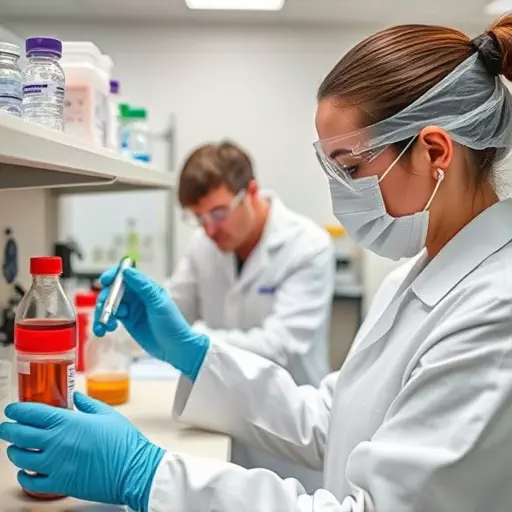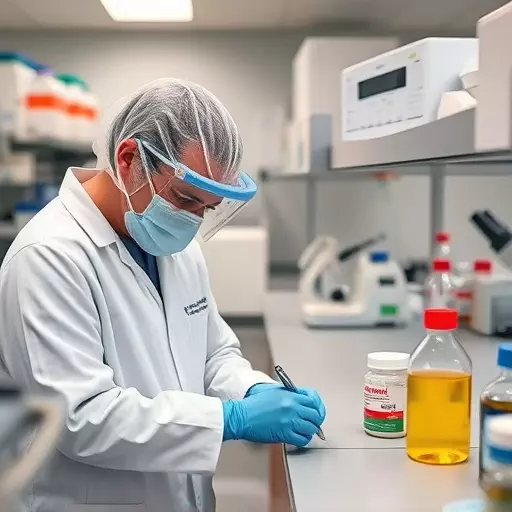Marine biodiversity monitoring in South Bend-Mishawaka, IN (In-mi), through advanced lab work and animal testing, is crucial for identifying and tracking antibiotic-resistant bacteria (ARBs) that pose significant global health risks, especially in coastal areas. These labs detect emerging pathogens from animal hosts (zoonotic diseases), aiding in proactive monitoring and swift responses to potential outbreaks. By combining molecular diagnostics, metagenomics, field observations, and collaboration with global health labs, researchers aim to predict, prevent, and manage these outbreaks, enhancing public health security for coastal communities. Future strategies should focus on interdisciplinary collaboration and community engagement to effectively navigate the complex relationship between marine biodiversity and global health.
Marine biodiversity plays a crucial role in maintaining public health in coastal regions. This article explores the critical task of monitoring marine ecosystems for potential risks, focusing on three key aspects: understanding the impact of marine biodiversity on human health, the identification of antibiotic-resistant bacteria by global health labs, and the significance of animal testing labs in detecting zoonotic spillovers. By examining a local case study from South Bend-Mishawaka, MI, and discussing challenges and future innovations, we emphasize the importance of integrated research for enhancing public health safety.
- Understanding Marine Biodiversity and Its Impact on Public Health
- The Role of Global Health Labs in Identifying Resistant Bacterial Strains
- Monitoring Zoonotic Spillovers: Animal Testing Labs as Sentinels
- Case Study: Lab Work in South Bend-Mishawaka, MI – A Local Perspective
- Challenges and Innovations in Marine Biodiversity Monitoring
- Future Directions: Enhancing Public Health Safety Through Integrated Research
Understanding Marine Biodiversity and Its Impact on Public Health

Marine biodiversity encompasses the vast array of life forms found in oceans and coastal waters, from microscopic organisms to majestic whales. Understanding this intricate web is crucial for gauging public health risks, as marine ecosystems can serve as reservoirs for diverse pathogens, including bacteria, viruses, and parasites that pose potential threats to human populations. In the context of global health, labs across the world, including those in South Bend-Mishawaka, Michigan, play a pivotal role in identifying resistant bacterial strains that may have emerged due to environmental changes or improper management practices.
The impact of marine biodiversity on public health becomes evident through zoonotic spillovers, where diseases initially found in animals spread to humans. Monitoring these spillovers requires robust animal testing labs that can detect and characterize emerging pathogens. By combining lab work in South Bend-Mishawaka with global health efforts, scientists can better predict, prevent, and manage potential outbreaks, ensuring the well-being of coastal communities.
The Role of Global Health Labs in Identifying Resistant Bacterial Strains

Global Health Labs located in areas like South Bend-Mishawaka, IN, play a pivotal role in identifying resistant bacterial strains that pose significant risks to public health, especially in coastal regions. These labs employ advanced diagnostic tools and culturing techniques to detect and characterize emerging pathogens, including antibiotic-resistant bacteria (ARBs). By monitoring local ecosystems and conducting thorough lab work, researchers can track the presence and spread of these dangerous strains, which often spill over from animal hosts, as seen in several zoonotic diseases.
The capability to identify resistant bacterial strains early on is crucial for implementing effective public health strategies. Animal testing labs within these global health facilities contribute significantly to this effort by simulating environmental conditions and studying animal-human interactions. This proactive monitoring helps anticipate potential outbreaks, allowing for swift responses to mitigate risks associated with marine biodiversity, ensuring the well-being of coastal communities.
Monitoring Zoonotic Spillovers: Animal Testing Labs as Sentinels

Monitoring zoonotic spillovers is a critical component of assessing public health risks along coastal regions. Animal testing labs, especially those engaged in lab work in South Bend-Mishawaka, IN, play a crucial role in identifying resistant bacterial strains that may pose significant global health threats. By studying animal populations and their interactions with human activities, these labs help detect emerging pathogens before they spill over into human communities.
In-mi (Indiana) facilities are well-equipped to conduct thorough analyses of marine ecosystems, enabling them to monitor zoonotic disease transmission pathways. This proactive approach allows researchers to gain valuable insights into potential public health crises. Identifying and understanding resistant bacterial strains in these labs is essential for developing effective countermeasures, ensuring the resilience of both animal and human populations against infectious diseases.
Case Study: Lab Work in South Bend-Mishawaka, MI – A Local Perspective

In South Bend-Mishawaka, Michigan, local researchers have been actively involved in monitoring marine biodiversity for public health risks. A case study from this region highlights the collaborative efforts between global health labs and animal testing facilities. By identifying resistant bacterial strains in these specialized labs, scientists gain crucial insights into potential zoonotic spillovers—diseases transmitted from animals to humans. This local perspective underscores the importance of continuous surveillance, especially considering the increasing human activities in coastal regions that can disrupt marine ecosystems.
The lab work in South Bend-Mishawaka focuses on analyzing water samples and studying animal populations to track any unusual patterns or emerging pathogens. These efforts are integral to predicting and mitigating public health crises before they escalate. By combining advanced diagnostic tools with a deep understanding of local ecosystems, researchers here contribute significantly to global health security, ensuring that coastal communities remain resilient against potential outbreaks.
Challenges and Innovations in Marine Biodiversity Monitoring

Monitoring marine biodiversity for public health risks presents several unique challenges. One significant hurdle is the vast and varied nature of coastal ecosystems, making comprehensive sampling and analysis a complex task. Additionally, the dynamic environment poses logistical difficulties, as researchers must adapt to changing conditions like tide schedules and weather patterns. However, these challenges have also catalyzed innovations in monitoring techniques.
Scientific institutions, including those engaging in lab work in South Bend-Mishawaka, Indiana, are leveraging advanced technologies such as molecular diagnostics and metagenomics to identify resistant bacterial strains that could pose global health risks. By integrating data from various sources—from field observations to animal testing labs—scientists aim to predict and prevent zoonotic spillovers, where diseases jump from animals to humans. This multidisciplinary approach, combining both lab and field research, is revolutionizing how we monitor and protect public health in coastal regions.
Future Directions: Enhancing Public Health Safety Through Integrated Research

Looking ahead, integrating marine biodiversity monitoring with public health research holds immense potential to fortify coastal communities against emerging risks. Future directions should focus on fostering collaboration between lab work in South Bend-Mishawaka in-MI, global health labs specializing in identifying resistant bacterial strains, and animal testing facilities for monitoring zoonotic spillovers. This holistic approach will enable scientists to track the migration of pathogenic organisms from marine ecosystems into human populations, providing early warning systems for potential outbreaks. By combining advanced molecular techniques with traditional surveillance methods, researchers can develop more effective prevention and control strategies tailored to local conditions.
Moreover, expanding these integrated research efforts could involve community engagement in data collection, leveraging citizen science initiatives to monitor coastal areas for unusual biodiversity patterns or disease indicators. This bottom-up approach not only augmentes the volume of data but also fosters a sense of collective responsibility for public health safety. Ultimately, enhancing inter-disciplinary collaboration and community participation will be crucial in navigating the complex web of marine biodiversity and its implications for global health.
